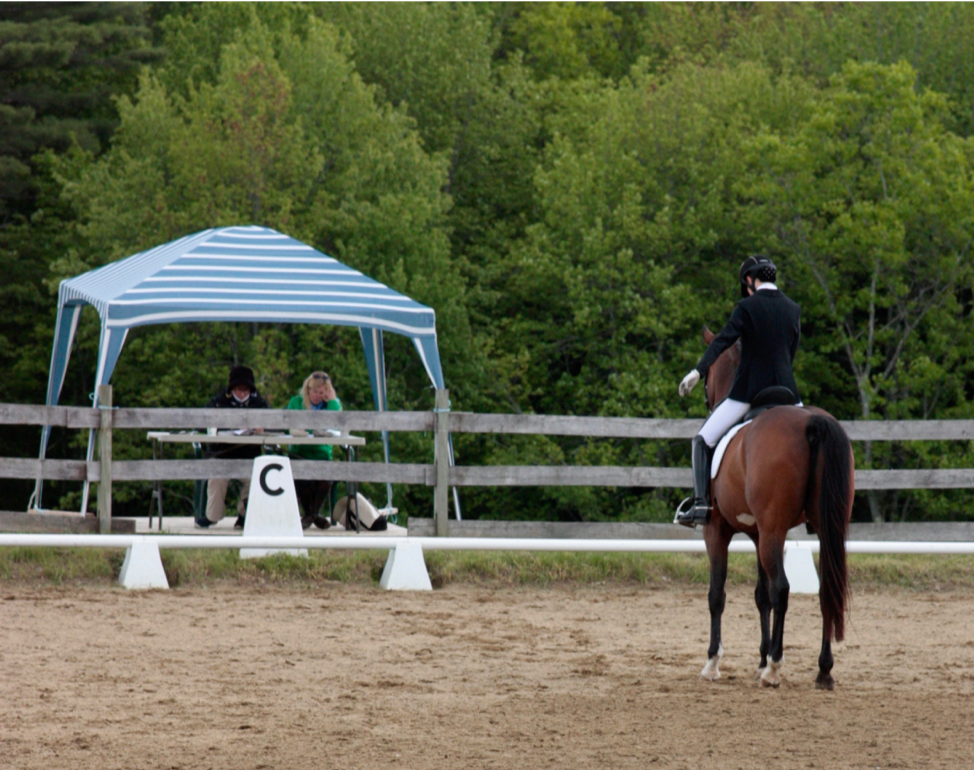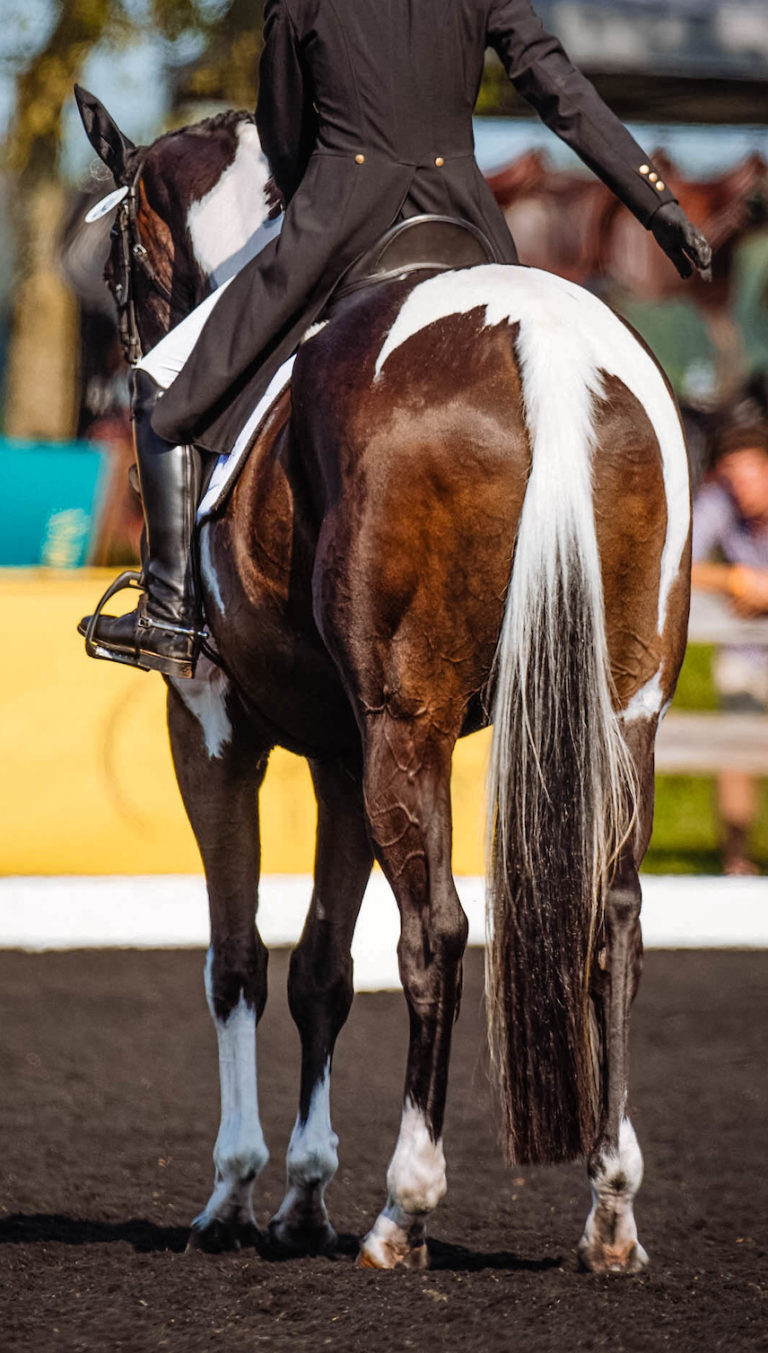
So, you’re hoping to one day compete in the Adequan®/FEI North American Youth Championships (NAYC) presented by Gotham North? Congratulations! The NAYC, formerly known as the North American Junior/Young Rider Championships (NAJYRC), is a goal that hundreds of young equestrians pursue every year.
The FEI North American Youth Championships for dressage is the premier equestrian competition in North America for junior and young riders and is the only FEI championship held annually on this continent.
The NAYC hosts teams of different age, nationality and discipline, bringing together a wide range of young equestrians. To ride in the Championships is a dream and ultimate goal for many young riders.
That dream finally became a possible reality for me when I bought my first, very own horse, Spotlight. Spotlight and I partnered in October 2016 and by January had decided to aim for the Championships. The next six months became both the most exciting and the most stressful time.
The overwhelming to-do list, the expectations from my peers, and the instinctive desire to not only make it to the Championships but to place highly was crazy! I was so lucky to have an incredibly supportive team with me, mainly in my trainer, my riding buddy (in the same exact boat as I), and my parents.
Though Spotlight and I narrowly missed a spot on the Region 8 team in 2017, going through the qualification process opened my eyes to just how much of a commitment it is to declare your intention to shoot for the NAYC.
After a turbulent winter, Spotlight and I are more ready than ever to tackle this enormous challenge. I hope that this three-part blog will help my fellow young riders know what to expect during this process.
About the Competition
The competition is run under the FEI (Fédération Équestre Internationale), the international governing body of equestrian sport. In an international championship, teams of four from multiple “countries” (or in this case, multiple “regions” from the U.S., Canada, and Mexico) compete in team and individual classes. Each competitor is selected based on their scores earned throughout the qualifying period. Once the team has been chosen, an appointed Regional Coordinator will organize the riders before and during the Championships.
In years past, the NAYC invited five of the FEI’s recognized horse sports: dressage and para-dressage, show jumping, reining, eventing and endurance. However, in 2018, the competition will host show jumping, eventing, and dressage. Within each discipline, there are two age divisions: Junior (ages 14-18), and Young Rider (ages 16-21). Each age division has different expectations of the horse and rider combinations.
At the beginning of the championships, every athlete presents their horse in a mandatory inspection. Vital to a team’s ability to compete, each combination must show to the competition’s veterinary delegate and ground jury (judges) that their horse is healthy and sound. The rider brings their horse’s identification papers to the inspection and jogs from and toward the panel, which evaluates the horse’s health and soundness. Strictly held for the welfare of the horse, the jog ensures that each horse is fit to compete for the challenging week to come.
Once accepted into the competition, the athletes perform three tests, for Team and Individual placings. The first test, the Team test, is ridden by all riders, with each team’s average calculated for their overall team placing. Next is the Individual test, which decides each rider’s individual placing as well as who will compete in the final phase of the competition. The top 15 individuals compete to their personal tests to music, “Freestyles,” to determine the final individual placings.
As the United States Dressage Federation (USDF) explains, “qualifying to ride at this competition is an accomplishment in itself. However, many riders have serious aspirations to make the top 12, or maybe win a medal. Some riders have a goal to someday compete on an international level, and the results of this competition may help them toward that goal. Although this should be a fun and rewarding experience for all riders, the serious nature of this competition needs to be realized.” There are many tasks you need accomplish to begin the process of qualifying and knowing the steps ahead of time will help you stay organized and have a more enjoyable experience.
Where to Begin?
Qualifying for the NAYC is a lengthy process for which you need to plan months in advance. First and foremost, you should explore the “New to NAYC” page on the USDF website, accessible through the NAYC homepage. Here, you can find an overview of the competition, a list of terms and definitions, and a step-by-step breakdown of what you need to do to qualify. But before you begin the qualifying process, you will need to get your memberships in order.
•The athlete must have a USDF Participating Membership, USEF Junior Active/Senior Active/Lifetime Membership and an FEI Rider Registration.
•The horse must have a USDF Lifetime Registration, USEF Lifetime Recording, FEI Registration, and an FEI Passport.
•The horse’s owner must have a USDF Participating/Business Membership, and a USEF Junior Active/Senior Active/Lifetime Membership.
In addition to the memberships listed above, I would highly recommend joining your local Group Member Organizations (GMOs), such as the New England Dressage Association. Not only are most of these clubs organizing your qualifying shows, but may even be willing to sponsor your region!
Once your horse has all his memberships in order, he must also have an FEI passport that is in good standing. Before applying for a passport:
1. Fulfill all membership requirements outlined above (ensuring that the horse is lifetime recorded).
2. Ensure that the ownership of the horse is the same under all three registrations.
3. Know that the horse’s name must be the same under all three federations.
4. Check if your horse has a microchip. Many horses are microchipped at a young age, but your veterinarian should verify the chip and its compliance with the FEI.
The first step in obtaining an FEI passport is filling out the “USEF/FEI Passport Service Application” (previously titled “New Passport Application”), to be sent to the USEF. This document also has all the information you need on how to obtain a passport. Once the USEF receives your application, the Passport Department will mail you an empty booklet, in which your veterinarian* will complete the necessary information, in-cluding a diagram of your horse. You must then return it to the USEF to be registered and stamped. If the book has been prepared correctly, they will send it back to you, and you will be all set to compete internationally!
Note that it is ideal to have a veterinarian with FEI experience to help you in the passport process. They should be knowledgeable about microchip requirements, vaccination requirements and in diagraming your horse.
Last year after applying for a passport, receiving the little purple book in the mail and filling out the appropriate information, we purchased postal insurance for Spotlight’s passport and sent it back to the USDF headquarters in Lexington, Kentucky.
The insurance came with the promise that we would be able to track the passport during every step of its journey to Lexington and that it would remain in a locked safe at each checkpoint. After more than one week passed and the package was still not in Lexington, we contacted the mailing company. The passport had been misplaced, and was now sitting in a warehouse in Utah! Thus we learned our first lesson in the process: be a “helicopter” and pay close attention!
If your horse already has an FEI passport that has been created or updated within the last four years, you only need to renew the USDF, USEF, and FEI registrations. Go to this link to learn how to update an old passport, if it is five years or older.
Once all memberships and registrations are met, and the passport application sent in, you must apply for the NAYC. Before the deadline of May 2nd, submit your Application of Intent online to the USDF, along with $50. If you miss this initial deadline, you have until May 15th to submit with a fee of $300. After applying, you will receive a confirmation email.
Know Your Resources
Throughout this process, is vitally important to know who you can go to for help. The knowledgeable staff at the USDF, USEF and FEI want to help you! Whether you are struggling with the membership requirements, passport process, or qualifying process, no one will dismiss your questions. I have emailed many people from all three federations and always received patience and expertise in return.
As I mentioned before, it is also beneficial to have a knowledgeable veterinarian on hand.
Perhaps your most valuable resources are your Regional Coordinator and Chef d’Equipe, responsible for helping you stay organized through the whole NAYC process, from declaration to the awards ceremony. These people are not only well-versed in the ins and outs of the federations, but have many contacts to reach out to for help.
As the rider, it is your responsibility to know the rules! Pay attention to any illegal substances that might reach your horse by checking the FEI’s CleanSport database or download the app to look up substances any time. The USEF and FEI rulebooks are also vital resources with which you should become familiar.
Build Your Freestyle
There are many ways to go about creating a freestyle for you and your horse. To get started, you should have an idea of a genre of music as well as a list of your horse’s strengths and weaknesses. What type of music best suits you both? What kind of music will your horse tolerate in the ring? How much of a risk are you willing to take in the test?
Most people create the choreography first, usually with their trainer, and video the test in a regulation arena. Doing this will allow you to match the music to your horse, with or without a professional freestyle designer. There are many people available to help you find and alter music to best suit you.
If funding is an issue when deciding whether or not to hire a professional freestyle designer, there are other alternatives. One music editing software program that comes free with all Mac laptops is Apple’s GarageBand. With this, you can import and alter songs to suit your freestyle. GarageBand also allows you to change the volume, tempo and arrangement of the music, adding transitions and moving sections of the songs around. There are also karaoke websites that offer songs with or without lyrics. The USDF reminds riders that although lyrics are permitted, instrumental music is preferred (read more about this here). Make sure that your music complies with copyright laws with this USDF article.
Before presenting your freestyle to a judge, it is imperative that you become familiar with the rules. What happens if the incorrect music plays over the loudspeakers? What should you do if your music cuts out during your test? Are you allowed to adjust the volume during your ride? Be sure to answer any questions you may have before you enter at A. It is your responsibility!

Eyes on the Prize
I know in my barn that the show season bug has taken hold! While the stress and anticipation of the first show buzz through our minds, it is essential to focus on your own goals. Stay organized, plan your schedule and read all of the information you can. Focus on keeping you and your equine partner healthy and happy and enjoy the ride!
Helpful Links
NAJYRC Information Email: najyc@usdf.org
Contact: Hannah Niebielski, Director of Dressage and National Programs hniebielski@usef.org
Passports:
NAYC Passport Requirements Guide
FEI Websites:











